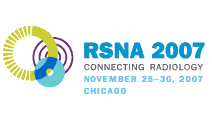
Abstract Archives of the RSNA, 2007
SSA01-07
Value of Magnetic Resonance Imaging for the Work-up of Invasive Lobular Breast Carcinoma: Prospective and Retrospective Study of 57 CasesóComparison with Physical Examination, Conventional Imaging, and Histology
Scientific Papers
Presented on November 25, 2007
Presented as part of SSA01: Breast Imaging (MR Imaging)
Thomas Caramella MD, Abstract Co-Author: Nothing to Disclose
Claire Chapellier, Abstract Co-Author: Nothing to Disclose
Francette Ettore, Abstract Co-Author: Nothing to Disclose
InŤs Raoust, Abstract Co-Author: Nothing to Disclose
Emmanuel Chamorey, Abstract Co-Author: Nothing to Disclose
Maestro Catherine MD, Presenter: Nothing to Disclose
Determination of the value of MRI for invasive lobular carcinoma (ILC), a diagnostic challenge for the radiologist.
57 patients with histologically-proven ILC were studied between 1998 and 2006. All patients underwent physical examination, mammography, ultrasound and
an MRI. All anomalies detected were graded using the BI-RADS classification and careful research was made for the presence of multifocal/multicentric disease. The histologic tumor size was compared with the other techniques.
66% of the tumors were palpable. The majority of the mammograms presented architectural distorsion (36%) or mass (53%), most of them with spiculated contours. On MRI, 72% were visualized as masses and 18% corresponded to a non-mass-like enhancement.
Size correlations, based on comparison with histology findings were: 0.88 (MRI, p<0.001),
0.57 (ultrasound), 0.53 (physical examination), and 0.40 (mammography).
The Kappa correlations for multifocal/multicentric disease were: 0.87 (MRI), 0.22
(ultrasound), and 0.22 (mammography). MRI had a sensitivity and specificity of 100% and
87%. The therapeutic strategy was modified in 49% of cases.
MRI is unquestionably valuable for the management of ILC. It provides the most accurate estimate of tumor size and is highly sensitive for multifocal/multicentric
disease. Its main drawback is a lack of specificity that requires preoperative histologic
verification. MRI often justifies modification of the initial therapeutic strategy, generally by ruling out a conservative procedure.
Lobular carcinoma, breast neoplasm, magnetic resonance imaging
Caramella, T,
Chapellier, C,
Ettore, F,
Raoust, I,
Chamorey, E,
Catherine, M,
Value of Magnetic Resonance Imaging for the Work-up of Invasive Lobular Breast Carcinoma: Prospective and Retrospective Study of 57 CasesóComparison with Physical Examination, Conventional Imaging, and Histology. Radiological Society of North America 2007 Scientific Assembly and Annual Meeting, November 25 - November 30, 2007 ,Chicago IL.
http://archive.rsna.org/2007/5010731.html

